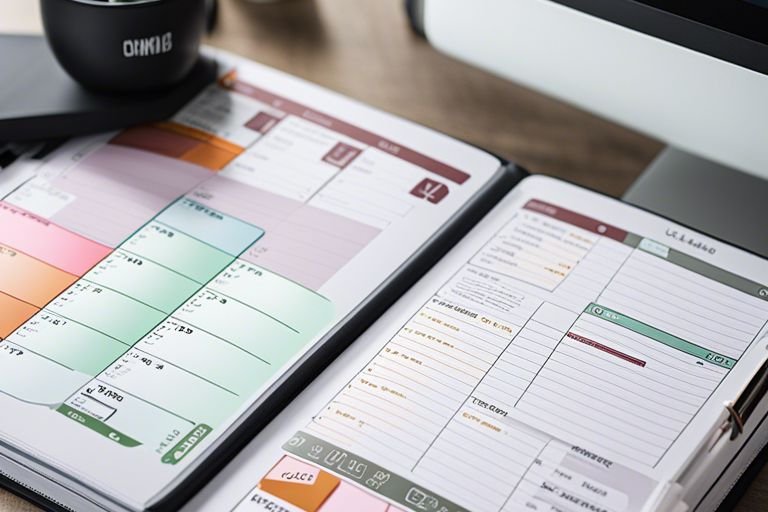Overwhelmed by your never-ending to-do list? Time blocking might just be the solution you need to boost your productivity. In this ultimate guide, we will walk you through the ins and outs of time blocking, its benefits, and how to effectively implement this time management technique into your daily routine. Say goodbye to multitasking and hello to focused, efficient work with the power of time blocking!
Key Takeaways:
- Effective time management: Time blocking helps you allocate specific time periods for tasks, leading to better organization and productivity.
- Focus and concentration: By dedicating uninterrupted blocks of time to tasks, you can minimize distractions and increase focus on the task at hand.
- Flexibility and adaptability: Time blocking allows for adjustments and changes to your schedule while still ensuring that important tasks are completed.
Understanding Time Blocking
Definition and Principles
Even though time blocking has become a popular productivity technique in recent years, its principles have been around for centuries. The concept is simple: allocate specific blocks of time for different tasks or activities throughout your day. By creating a schedule that outlines exactly what you will be working on at any given time, you can eliminate distractions and focus on the task at hand.
History and Evolution of Time Blocking
Even dating back to ancient civilizations, people have recognized the importance of organizing their time. The concept of time blocking can be traced through various historical figures who were known for their productivity and time management skills. From Benjamin Franklin to modern-day entrepreneurs, the practice of dividing your day into dedicated time slots for work, rest, and play has proven to be a key factor in achieving success.
Now, with the rise of digital tools and apps designed to help individuals implement time blocking effectively, this productivity technique has become more accessible to everyone. With just a few clicks, you can create a detailed schedule that maps out your entire day, ensuring that you make the most of your time and stay on track with your goals.
Time
Time blocking is not just about managing your time efficiently; it’s also about prioritizing what truly matters to you. By consciously setting aside time for important tasks and activities, you are taking control of your schedule and ensuring that you make progress towards your long-term objectives. Whether it’s work projects, personal development, or self-care, time blocking allows you to allocate dedicated time slots for each area of your life, leading to a more balanced and fulfilling lifestyle.

Types of Time Blocking
Even though time blocking is a flexible productivity tool, there are various types you can use to cater to different needs. Assume that by understanding the different types of time blocking, you can choose the one that works best for you.
| Fixed Time Blocking | Flexible Time Blocking |
|---|---|
| Set specific time slots for each task. | Allows for adjustments during the day. |
| Best for individuals with predictable schedules. | Great for handling unexpected events. |
| Can create a routine and increase efficiency. | Offers more adaptability and spontaneity. |
| May cause stress if tasks take longer than planned. | Requires good time management and self-discipline. |
| Helps in sticking to a rigid timetable. | Allows for prioritizing tasks in real-time. |
Fixed Time Blocking
An effective way to structure your day is by using fixed time blocking. By allocating specific time slots for each task, you create a routine that can increase your productivity. This method is best for individuals with predictable schedules, as it helps in sticking to a rigid timetable. However, it’s important to note that fixed time blocking may cause stress if tasks take longer than planned.
Flexible Time Blocking
Blocking out chunks of time for tasks, rather than specific times, is the essence of flexible time blocking. This method allows for adjustments during the day, making it great for handling unexpected events. While it offers more adaptability and spontaneity, flexible time blocking requires good time management and self-discipline. A balance between structure and flexibility is key to making flexible time blocking work for you.
Priority-Based Time Blocking
Time blocking based on priorities involves allocating your time according to the importance of tasks. By focusing on high-priority activities first, you ensure that your most critical tasks are completed. This method helps in real-time prioritization of tasks, enabling you to adapt to changing circumstances throughout the day.
Task-Oriented Time Blocking
Clearly defining tasks and allocating specific blocks of time to work on them characterizes task-oriented time blocking. This method allows for a more focused approach to each task, resulting in increased efficiency and productivity. Understanding the time needed for each task and prioritizing them accordingly can help you make the most of your time.
Factors to Consider When Implementing Time Blocking
Many factors play a crucial role in successfully implementing time blocking strategies. It’s crucial to consider various elements to maximize the effectiveness of this productivity tool. Here are some key factors to keep in mind:
- Identifying Your Most Productive Hours
- Understanding Your Task Priorities
- Managing Distractions and Interruptions
- Balancing Work and Personal Life
Identifying Your Most Productive Hours
Some individuals are early birds, while others are night owls. Understanding when you are most productive can help you schedule your most important tasks during that time. Take note of when you feel most alert, focused, and energized throughout the day. This self-awareness will enable you to allocate your most challenging or critical tasks during your peak productivity hours, enhancing your efficiency and effectiveness.
Understanding Your Task Priorities
Identifying your task priorities is crucial when implementing time blocking. Categorize your tasks based on urgency and importance to ensure that you allocate sufficient time for crucial activities. By distinguishing between tasks that are time-sensitive and those that are more flexible, you can create a well-balanced schedule that addresses your most pressing needs first. Your task priorities will guide you in determining how to allocate your time effectively and achieve optimal results.
Managing Distractions and Interruptions
Identifying and minimizing distractions and interruptions are crucial for successful time blocking. Evaluate your work environment and identify potential sources of distractions that may derail your productivity. Implement strategies such as setting boundaries, turning off notifications, and creating a dedicated workspace to limit interruptions. By proactively managing distractions, you can maintain focus and stay on track with your scheduled tasks.
Balancing Work and Personal Life
The key to sustainable productivity is maintaining a healthy work-life balance. When implementing time blocking, it’s crucial to allocate time not only for work-related tasks but also for personal activities, relaxation, and self-care. Schedule breaks, exercise sessions, and quality time with loved ones to recharge and avoid burnout. The ultimate goal of time blocking is not just to increase productivity but also to enhance overall well-being and fulfillment.
Plus,
Many factors contribute to the successful implementation of time blocking, but understanding your unique preferences, priorities, and boundaries is key to optimizing this productivity technique. By carefully considering these factors and making adjustments as needed, you can effectively leverage time blocking to boost your productivity and achieve a more balanced and fulfilling lifestyle.
Step-by-Step Guide to Implementing Time Blocking
Unlike other productivity techniques, time blocking is a highly effective way to manage your schedule and make the most out of your day. It involves breaking down your day into blocks of time dedicated to specific tasks or activities, allowing you to focus on one thing at a time without distractions. Here is a step-by-step guide to help you implement time blocking successfully.
| Setting Up Your Calendar | Scheduling Tasks and Activities |
Setting Up Your Calendar
While setting up your calendar for time blocking, start by identifying your high-priority tasks and commitments. Color-code your calendar to distinguish between work-related tasks, personal activities, and breaks. Make sure to allocate realistic time frames for each activity to avoid overloading your schedule.
Scheduling Tasks and Activities
Activities such as checking emails, making phone calls, or attending meetings should be assigned specific time blocks in your calendar. This ensures that you allocate the necessary time for these tasks without letting them disrupt your workflow. By scheduling your day in advance, you can better manage your time and stay on track to accomplish your goals.
Setting aside time blocks for deep work or focused tasks is crucial for maximizing productivity. These blocks should be free from distractions and interruptions, allowing you to concentrate fully on the task at hand. By allocating dedicated time for important tasks, you can make significant progress and avoid multitasking.
Creating a Daily Routine
While creating a daily routine with time blocking, consider your natural energy levels and peak productivity times. Schedule your most demanding tasks during periods when you feel most alert and focused. Incorporate breaks and downtime into your schedule to avoid burnout and maintain a healthy work-life balance.
A consistent daily routine with time blocking can help you establish good habits and increase your efficiency over time. By sticking to a predetermined schedule, you develop a sense of discipline and structure that fosters productivity. Adjust your routine as needed to accommodate unforeseen events or changes in priorities.
Reviewing and Adjusting Your Schedule
Daily review of your time-blocked schedule allows you to assess your progress, identify areas for improvement, and make necessary adjustments. Reflect on how effectively you utilized each time block and evaluate whether your goals were met. Use this feedback to refine your time blocking strategy for better productivity in the future.
Plus, periodically reviewing and adjusting your schedule enables you to adapt to evolving priorities and optimize your time management. Be flexible in modifying your time blocks to accommodate new tasks or shifting deadlines. By continuously refining your schedule, you can enhance productivity and achieve greater success in your endeavors.
Tips for Effective Time Blocking
Start Small and Be Consistent
All successful time blockers started small and gradually built up their time blocking skills. Begin with just one or two hours of time blocking each day and gradually increase as you become more comfortable with the process. Consistency is key, so try to stick to your time blocking schedule even on days when it might be challenging.
Any interruptions or deviations from your time blocking schedule are opportunities to learn and adjust for the future. Use these instances as a way to improve your time blocking skills and make your schedule even more effective.
Leave Buffers for Unexpected Tasks
While time blocking is great for planning your day, it’s imperative to leave some buffers in your schedule for unexpected tasks or emergencies that may come up. By allocating extra time for these unforeseen events, you can ensure that your entire day won’t be thrown off track.
Leaving buffers in your time blocking schedule also allows for some flexibility and prevents you from feeling overwhelmed if tasks take longer than expected or if something urgent comes up that needs your immediate attention.
Use Technology to Your Advantage
Tips for effective time blocking include utilizing technology to help streamline and organize your schedule. There are a variety of time blocking apps and tools available that can assist you in creating, managing, and adjusting your time blocking schedule. These tools can send you reminders, sync with your calendar, and provide valuable insights into how you are spending your time.
Small investments in learning how to use these technologies can yield significant returns in terms of productivity and time management. By leveraging these tools, you can make your time blocking more efficient and effective.
Review and Adjust Regularly
Your time blocking schedule should not be set in stone. It’s imperative to regularly review and adjust your schedule based on what is and isn’t working for you. Make it a habit to reflect on your time blocking effectiveness, identify any areas for improvement, and make the necessary adjustments to optimize your schedule.
Leave room for flexibility in your time blocking routine so that you can accommodate changes in your workload, priorities, and personal commitments. By regularly reviewing and adjusting your time blocking schedule, you can ensure that it continues to serve you well and enhances your productivity over time.
Pros and Cons of Time Blocking
| Pros | Cons |
| Increased productivity and efficiency | Reduced flexibility in daily schedule |
| Improved work-life balance | Can be challenging to stick to rigid time slots |
| Reduced stress and anxiety | May require constant adjustment and fine-tuning |
| Enhanced focus on tasks and priorities | Over-planning can lead to burnout |
| Better time management and organization | Not suitable for everyone’s working style |
Increased Productivity and Efficiency
Blocking out specific time slots for tasks can help you focus better and avoid distractions, leading to increased productivity and efficiency.
Improved Work-Life Balance
You may find that time blocking allows you to allocate dedicated time for work as well as personal activities, helping you achieve a better work-life balance.
By setting aside time for relaxation, hobbies, and spending time with loved ones, you can prevent work from encroaching on your personal life.
Reduced Stress and Anxiety
On top of boosting productivity, time blocking can also help reduce stress and anxiety by providing a clear plan for the day and ensuring that tasks are completed within specific time frames.
Potential Drawbacks and Limitations
While time blocking can be highly beneficial, there are potential drawbacks and limitations to consider. It’s important to be aware of these factors before adopting this productivity technique to ensure its effectiveness.
Final Words
Hence, time blocking is an incredibly effective technique for increasing productivity and achieving your goals. By breaking down your day into specific tasks and allocating dedicated time slots for each one, you can minimize distractions, prioritize important activities, and make the most of your time. Consistent implementation of time blocking can lead to better time management, improved focus, and a greater sense of accomplishment.
Keep in mind, time blocking is a flexible tool that can be tailored to suit your individual needs and preferences. Experiment with different approaches, find what works best for you, and make adjustments as necessary. With dedication and practice, time blocking can revolutionize the way you work and help you reach new levels of productivity and efficiency.
FAQ
Q: What is time blocking?
A: Time blocking is a time management technique where you divide your day into blocks of time dedicated to specific tasks or activities. By scheduling your day in this way, you can focus on one task at a time, avoid multitasking, and improve productivity.
Q: How can time blocking help increase productivity?
A: Time blocking can help increase productivity by providing structure to your day and allowing you to prioritize tasks effectively. By allocating specific blocks of time to different activities, you can focus on each task without distractions and make progress towards your goals.
What are some tips for effective time blocking?
A: To make the most of time blocking, consider the following tips:
– Start by identifying your most important tasks or goals.
– Break down larger tasks into smaller, more manageable blocks of time.
– Allocate buffer time between blocks to account for unexpected delays.
– Regularly review and adjust your time blocks based on your productivity and progress.
– Use tools like calendars or apps to create and visualize your time blocks.








